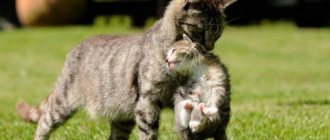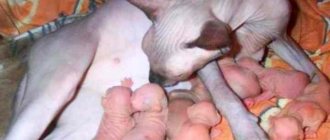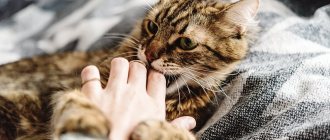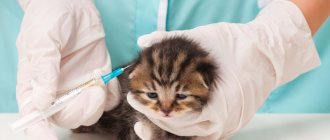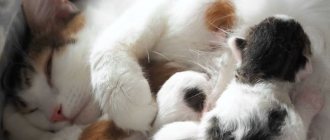Biting as a method of education
Nature has not given a cat much time to feed and raise its offspring. As a rule, after 2 - 3 months the female is again ready for fertilization and gestation. Therefore, in a short period of time, the mother must raise and teach her cubs the laws of survival in harsh reality. At the same time, the learning process involves not only biting the baby; those who are especially slow-witted can get hit with a paw. The cat is trying to instill in the young the rules of good manners, how it is possible and how it should not behave in a given environment. At the time of upbringing, the mother can persistently, but without causing injury or leaving marks, bite the child until it understands what is required of it.
Taking care of her offspring, the mother closely monitors that all the kittens are in her field of vision, in the best case - in the nest. And if a particularly nimble and restless baby constantly tries to leave the house, tries to crawl away or run away, the cat applies appropriate educational measures to him, bites him and demands obedience.
Quite often, the mother herself accustoms her babies to the tray. And if the kitten does not understand what is required of him and refuses to go to the toilet in a specially designated place, the pet, as a rule, takes strict measures to raise the careless cub.
A mother cat may bite her kittens when she is tired, wants to rest, and naughty children are too annoying and disturb her.
Kitten bites by mother: parenting methods or a warning sign about problems?
Carefully observing the relationship between a cat and kittens, owners often notice that the pet does not show very warm and tender feelings towards its cubs. The reasons why a cat bites its kittens usually lie in ancient natural instincts, but sometimes they are also caused by external factors.
Nature has not given a cat much time to feed and raise its offspring. As a rule, after 2 - 3 months the female is again ready for fertilization and gestation. Therefore, in a short period of time, the mother must raise and teach her cubs the laws of survival in harsh reality. At the same time, the learning process involves not only biting the baby; those who are especially slow-witted can get hit with a paw.
Taking care of her offspring, the mother closely monitors that all the kittens are in her field of vision, in the best case - in the nest. And if a particularly nimble and restless baby constantly tries to leave the house, tries to crawl away or run away, the cat applies appropriate educational measures to him, bites him and demands obedience.
Quite often, the mother herself accustoms her babies to the tray. And if the kitten does not understand what is required of him and refuses to go to the toilet in a specially designated place, the pet, as a rule, takes strict measures to raise the careless cub.
A mother cat may bite her kittens when she is tired, wants to rest, and naughty children are too annoying and disturb her.
Not only the mother, but also the father can teach the baby to be smart. The reasons why a cat bites a kitten on the neck are often related to the educational process and the establishment of authority. This happens if the father lives in the same room with his offspring, or when a kitten comes into the house where an adult male lives.
Self defense lessons
In the wild, a young animal faces various dangers. Therefore, the task of any mother is the need to teach her offspring to repel the enemy. And even though domesticated cats are no longer threatened by serious predators, nevertheless, at the genetic level, the pet must teach its offspring self-defense skills.
READ Pregnancy in a cat: what the owner needs to know
Therefore, you can often see a picture of a cat biting kittens on the neck. Thus, the animal shows which place is the most vulnerable in a fight with an opponent, in the fight against a predator, and teaches kids to avoid the invasion of a stranger into this part of the body. Self-defense lessons are usually held in the form of a game. The mother does not cause serious injuries to the kitten; she does not bite painfully, slightly squeezing the skin.
The skills acquired from the mother will help the young survive in the future, defend themselves and their territory in front of their relatives, and fight back against an offender or predator.
Fluffy pets are born hunters with a highly developed hunting instinct. The mother begins to teach the kittens the wisdom of hunting as soon as they grow up and get stronger. The cat bites its cubs, showing them how to grab and hold prey so that it does not escape.
Most often you can observe the following picture: the mother grabs the baby with her front paws, bites him on the neck and beats him with her hind legs. Thus, the animal demonstrates basic hunting techniques. After the kittens receive such a master class, they begin to hone their hunting skills on each other.
This process is also controlled by the cat. And as soon as, in her opinion, the kids start playing, she intervenes, gently biting them on the neck.
Biting kittens is not always an educational moment or a manifestation of natural instinct. If the animal is exhausted after childbirth, weakened, it is difficult for him to control his behavior. In this case, the cubs are perceived negatively by the mother, and she may even try to get rid of them. The bites in this case are aggressive in nature.
Often the reason why a cat bites newborn kittens is a serious illness of the mother - postpartum eclampsia or milk fever. The disease occurs due to the development of calcium deficiency in the body. A low level of the mineral leads to inadequate mental behavior of the animal, provokes aggression and convulsions. The cat's coordination of movement is impaired and drooling is observed. Body temperature rises to 410 C.
During attacks, the mother may exhibit uncontrollable aggression towards her offspring. This condition requires urgent veterinary care, as the animal may die from depression of the respiratory center or cardiac arrest.
It is not difficult to understand that a mother cat is aggressive towards her kittens. During training or games, despite the biting, the cat remains tender and affectionate towards the offspring, she periodically licks and caresses them. Biting is usually very gentle and does not leave marks on the body.
When can a kitten be taken away from a cat?
Self defense lessons
In the wild, a young animal faces various dangers. Therefore, the task of any mother is the need to teach her offspring to repel the enemy. And even though domesticated cats are no longer threatened by serious predators, nevertheless, at the genetic level, the pet must teach its offspring self-defense skills.
Therefore, you can often see a picture of a cat biting kittens on the neck. Thus, the animal shows which place is the most vulnerable in a fight with an opponent, in the fight against a predator, and teaches kids to avoid the invasion of a stranger into this part of the body. Self-defense lessons are usually held in the form of a game. The mother does not cause serious injuries to the kitten; she does not bite painfully, slightly squeezing the skin.
Natural hunting instincts
Fluffy pets are born hunters with a highly developed hunting instinct. The mother begins to teach the kittens the wisdom of hunting as soon as they grow up and get stronger. The cat bites its cubs, showing them how to grab and hold prey so that it does not escape.
Most often you can observe the following picture: the mother grabs the baby with her front paws, bites him on the neck and beats him with her hind legs. Thus, the animal demonstrates basic hunting techniques. After the kittens receive such a master class, they begin to hone their hunting skills on each other.
This process is also controlled by the cat. And as soon as, in her opinion, the kids start playing, she intervenes, gently biting them on the neck.
The reason lies in the disease
Biting kittens is not always an educational moment or a manifestation of natural instinct. If the animal is exhausted after childbirth, weakened, it is difficult for him to control his behavior. In this case, the cubs are perceived negatively by the mother, and she may even try to get rid of them. The bites in this case are aggressive in nature.
Often the reason why a cat bites newborn kittens is a serious illness of the mother - postpartum eclampsia or milk fever. The disease occurs due to the development of calcium deficiency in the body. A low level of the mineral leads to inadequate mental behavior of the animal, provokes aggression and convulsions. The cat's coordination of movement is impaired and drooling is observed. Body temperature rises to 410 C.
During attacks, the mother may exhibit uncontrollable aggression towards her offspring. This condition requires urgent veterinary care, as the animal may die from depression of the respiratory center or cardiac arrest.
Eclampsia in a cat: what are the signs and what to do?
Eclampsia (aka milk fever) is provoked by hypocalcemia - a disorder of calcium metabolism in the body, in which it begins to be sorely lacking. Milk fever usually develops in the first 2–3 weeks after lambing. This is due to the active leaching of calcium from the blood, due to the fact that it is involved in the formation of milk. Most common in mothers with multiple births.
Behavioral signals of developing eclampsia:
- Increased excitability and anxiety or lethargy and complete apathy;
- Aggression accompanied by lack of recognition of offspring and owners;
- Refusal to sit with own kittens;
- Avoidance of droppings feeding and biting, leaving marks on their skins;
- Frequently moving babies from place to place.
Physical signs of milk fever:
- Pointed muzzle with stretched skin and exposed fangs;
- Rapid breathing;
- Pale mucous membranes;
- Movements become abrupt;
- The animal has difficulty rearranging its “stiff” hind legs due to muscle spasms;
- Convulsions (intensity depends on the severity of the disease);
- Increased body temperature;
- Shiver;
- The pet often falls on its side;
- Uncontrollable salivation appears.
In a cat with eclampsia, the temperature rises to +41 °C. Carbon dioxide accumulates in the body, making it difficult for the animal to breathe. The pH in the blood increases and the calcium level decreases.
Milk fever is not so much dangerous for others as it is for a sick pet. If help is not provided in time, death from hyperthermia - due to depressed breathing and brain damage - will occur 12 hours after the onset of the attack.
If your pet has an acute attack of eclampsia, call your veterinarian immediately. Sometimes time passes by minutes, especially when an attack is not detected immediately, the doctor may simply not have time. It is in this case that, while waiting for the doctor, you will need to provide first aid to your pet yourself.
In case of an acute attack of eclampsia, it is necessary to inject subcutaneously:
- Fospasim or any other sedative - 1 ml;
- Gamavit - 1 ml;
- Calcium borgluconate (heated to 39°) - 2-3 ml at intervals of 45 minutes until symptoms disappear;
- No-shpa - 0.3 ml;
- Prednisolone - 0.5 ml.
After injections, place the cat in a dark, noise-free room until the attack stops. To prevent relapse, calcium (1 ml) will need to be injected 2 times a day for about two more weeks.
As the disease progresses, the kittens are taken from the mother cat and fed with an artificial formula, then returned. If the babies are more than 3 weeks old, introduce complementary foods; formula alone will no longer be enough for them.
Certain cats are more prone to milk fever than others. If your pet is predisposed to eclampsia - if such an attack has occurred at least once - it is necessary to pay special attention to her after lambing. In addition, it is worth worrying about the issue of prevention in advance by consulting with a veterinarian. As a rule, a diet with a high calcium content is prescribed. Cats at risk always have a fairly high chance of relapse. For such pets, the intervals between lambings should be as long as possible.
Other reasons
In addition to natural instincts and the educational process, there are other explanations why a cat bites its kittens:
- In order to stimulate their physical activity. Young animals must quickly build muscle mass, and for this, kids must move actively.
- The cat is unhappy with the nest, it is too hot, or it is located in a noisy place.
- The onset of heat. In this case, the female is aggressive towards the offspring and can bite her cubs.
- Foreign odors from kittens. Babies should not be touched with hands, as cats communicate using their sense of smell, and other people's smells can cause inappropriate behavior in the mother.
- Genetic abnormalities or hidden pathologies in kittens. Cats instinctively sense disturbances in the development of their young and can, by biting, check the viability of the offspring or try to get rid of them.
We teach cats and male cats not to bite
global $ads_google;
//data-ad-slot=”2475549904″ $ads_google = empty($ads_google) ? false : true; ?> if ($ads_google == false) {?> $ads_google = true; ?> } ?> Of course, to wean an animal from biting . To do this, you need to follow a number of rules and take educational measures.
When playing, you should not allow your pet to scratch your hands or grab your fingers with its teeth. The best way to have enough fun with your cat is to use a toy.
All household members and guests of the house should be prohibited from teasing the animal, as well as sharply waving their hands in front of it - in this case, the cat may regard fast movements as fleeing prey, which should be detained with teeth and claws. If the cat does grab and bite an arm or leg, then the animal’s head must be held tightly.
You can wean off such aggressive behavior with the help of loud or sharp sounds, towels, water, rattles, pillows. For example, a cat wants to bite its owner, but a towel or pillow is immediately thrown over it. Repeating such an action will be fixed in the animal’s mind with the negative consequences of the bite, and the desire to show its teeth will no longer arise.
If, in an attempt to wean an animal from the desire to bite and scratch a person, the method of loud sounds is chosen, then the main thing to remember is that the sound should follow the offense every time. Repetition will develop a reflex in your pet and an unpleasant association with the bite.
Raising a cat will bear fruit only with regular repetition and patience of the owner.
Weaning the kitten
With the light hand of the household, a tiny toy turns into a huge bite, if you ignore the advice to use toys instead of hands and fingers. Yes, at first it’s funny when a mini-tiger flies out from around the corner and tries to grab a person’s heel or finger with its teeth. And then it becomes not funny when the teeth not only bite, but already bite deep into the skin, even to the point of profuse bleeding - a child is unlikely to appreciate such an act of a playful grown-up kitten.
It is initially better to play with a kitten using all kinds of rustling toys and fishing rods and toys. So there will always be a distance between the owner’s inviolable body and the teeth.
Punishment should not be a call to confrontation, but a lesson, so a spray of water as a response will be an excellent brake for a raging animal.
If a kitten wants to bite and scratch, then it can be easily distracted by rustling sounds.
A child who has played enough and is tired will no longer want to run after someone’s legs, and even bite them.
Raising offspring
The role of the mother is not only to give birth and feed the child, but also to raise her. Mother cat is no exception. A cat can raise kittens with words (purring, meowing and hissing) and physical force: biting the kittens or giving in with its paw. The animal does not know any other way. Most often, cats bite their babies: this is the most effective method in nature.
While the babies are very small, the mother cat tries to hide her offspring from prying eyes. In case of unauthorized crawling out of the “nest”, the kitten may receive an educational bite. As a rule, the cat bites the kitten on the scruff of the neck, but does not leave any marks on the skin. A kitten’s squeak is not a cry of pain and a call for help, but an answer to its mother: “I won’t do it again!” After such a bite, the mother cat diligently licks the baby.
Grown-up kittens already receive permission to move freely around the territory of their residence and happily explore the new world. How can you do this without games? Kittens play with each other and with toys. Particularly playful youngsters strive to play with their mother’s tail. And immediately they receive an instructive bite in response or a blow with a paw. The cat teaches her kitten to stay within the bounds of decency and respect older, stronger fellow tribesmen.
Some cats teach their kittens to be clean and teach them to go to a certain place intended for natural needs. One tray in a house with kittens will not be enough. And naughty or slow-witted kittens receive punishment from their mother, again in the form of bites.
Bites as a health check and detection of weak litters
A cat bites kittens not only when raising them or in an attack of some disease. Remember the main law of animals: “survival of the fittest”? So, animals, unlike people, do not care for young animals with congenital diseases; on the contrary, they can behave very aggressively towards sick litters.
Cats, although domesticated, still have innate instincts that they cannot escape. Sick kittens will be detected by the pet just by biting. As already mentioned, by biting lightly, the cat checks the reflexes of the offspring, and if something does not suit her, she will abandon the sick baby. Be careful, there is a high probability that the mother will try to kill the baby who is unfit for life.
If you notice that one of the kittens stands out from the general heap of brothers or the mother cat is more aggressive towards one of them than towards the rest of the litter - sound the alarm, the kitten is sick. If you are going to keep him alive, take him to the vet. As a rule, after the sick baby is cured, the cat accepts him back and no longer shows hostility towards him.
It is better not to wait for your pet to attack the kittens, but to periodically examine them yourself, showing them to the doctor if necessary. The health status of furry babies can be determined “with the naked eye” by a number of signs.
Healthy kitten:
- It looks round and knocked down;
- Skin pink;
- Warm to the touch;
- If you gather the skin into a fold and let it go, it will straighten out immediately;
- On the palm of your hand, the baby stretches out and swings energetically.
Sick kitten:
- Lack of energy, barely moves, constantly lethargic;
- Hyperactive, but exhausted, falls asleep away from his brothers and mother;
- He sleeps with his limbs spread to the sides, his head tilted to the side;
- Noticeably cool to the touch;
- Skin has a bluish tint;
- When trying to eat, the nipple spits out;
- While awake, he continuously screams pitifully.
If, according to your observations, all the kittens are healthy, but the cat still shows obvious aggression towards one (or several) of them, she probably does not have enough milk. She may try to compensate for the lack of milk by weaning someone off the breast so that others can get enough. As a rule, the weakest descendant, even if not the sick one, is selected for this purpose.
Protection from dangers
Instincts dictate to cats that there are enemies in nature. Although in the modern living conditions of cats there are not many enemies, the kitten must be prepared to protect itself from them. A mother cat helps with learning. The most unprotected place on an animal is the scruff of the neck. This is where the cat most often bites her kittens, at the same time showing that you should avoid a bite from an enemy on the neck, but try to bite here yourself.
Lessons are usually held in the form of a game, the bites from the mother are weak. A little later, the kittens begin to practice the learned techniques on each other, diligently biting each other with sharp teeth. Here the bites are already real, sometimes either the owner or the mother cat has to intervene to separate the fighters. After such a school, an adult animal is able to protect itself from offenders, defend its authority in the cat environment, and conquer new territories of residence.
Hunting training
Another reason for kitten biting: hunting training. In this case, the cat pinches the kitten with its front paws and hits it with its hind paws. At the same time, the cat will bite its “prey”, managing to lick the bitten places. Practicing catch-and-hold hunting techniques is carried out both in pairs with a mother cat and with litter brothers and sisters. Later, elements of waiting in ambush, sudden jumps from cover, and pursuit will be added.
The mother cat first demonstrates all the hunting tricks to her children herself, and then happily participates in the pursuit of toy mice along with her kittens. Trained hunters will never be left without prey: all candy wrappers will be mercilessly caught. If a domestic cat has the right to go outside, then a real mouse or small bird can become prey.
All considered examples of biting are elements of education, rules of behavior in cat society, training in protection and hunting. If a cat does not harm her kittens and does not show increased aggressiveness towards them, then the owner has no reason to worry: she acts on the basis of her natural instincts.
Parenting with bites
We use the carrot and stick method when raising our children. A cat does the same thing. But nature gave her much less time for feeding and raising her offspring. Usually after 2-3 months the mother will be ready to bear kittens again, and in such a short period of time she must teach the cubs to survive in the harsh world. Therefore, the cat sometimes uses not only biting kittens, but also hits them with her paw. In this way, the mother tries to instill in the children the rules of conduct, teaches how not to behave. At such moments, she can bite the kitten without causing injury until he understands what is required of him. The cat always makes sure that all children are in her field of vision, in the nest and do not try to leave it. And when her most nimble and curious child shows disobedience, she forces him to obey. Sometimes the mother accustoms her cubs to the tray. And in this case, she also bites them and does not allow them to leave until they do the wet job.
Biting as an educational measure occurs when the cat gets tired, wants to sleep, and children climb on it like on a playground. She calms annoying and nimble children in this way. By the way, if dad lives next to his mother cat, then he can raise his offspring in the same way. This is how daddy cat demonstrates his authority and dominance.
Self defense lessons
There are always various dangers awaiting kittens on the street. Therefore, the mother is obliged to teach them to fight back the enemy. Even if the cat is domesticated and does not encounter serious predators, at the genetic level the mother is trying to teach her offspring self-defense skills. When she bites children on the neck, she shows them the most vulnerable place in a fight with an opponent - this is how she teaches them to avoid attacks from strangers.
Typically, cat self-defense lessons are played in a playful way. The mother bites the cubs lightly, pinching their skin. The skills acquired from her help the young to survive, defend themselves, their territory, and fight back against the offender.
Hunting instincts
Cats by nature are hunters. They have well developed hunting instincts. A mother can teach her cubs the wisdom of hunting when they are already grown up. She bites them, demonstrating how to capture and hold prey. Sometimes you can see how the mother cat grabs the baby with her front paws, beats him with her hind paws and bites him on the neck. So she teaches him basic hunting skills.
After such lessons, children can hone their skills on each other. And all this happens under the control of the mother. When they play too much, the cat intervenes and bites their neck, letting them know that it’s time to stop.
Cat diseases
Unfortunately, such an effect on the offspring can also be a symptom of the disease. If the cat’s birth was difficult, she is exhausted, then it is difficult for her to control her behavior. She perceives the cubs as irritants. In such cases, the bites are no longer sedative. The cat bites quite aggressively and persistently.
The most common reason for this dangerous behavior of a mother cat is postpartum eclampsia (milk fever). It is the result of a lack of calcium in the body. Its deficiency provokes inappropriate mental behavior of the mother. Sometimes even convulsions occur.
In such situations, there is no way to do without veterinary help. After all, a cat can simply die from depression of the respiratory center. For eclampsia, the doctor administers calcium gluconate intramuscularly. And kittens must be isolated from their mother during the treatment period, otherwise they are at risk of injury.
How to stop a cat from biting? Punish or ignore
Before we get to the “How to stop a cat from biting?” section, we need to look at the most common causes of aggression, as well as familiarize ourselves a little with cat psychology.
It is quite unpleasant to become an object of hatred, especially as a result of which the owner is constantly treating suppurations and trying to get rid of scars. It is worth noting that a small kitten or an adult cat always warns of an upcoming attack. Having already reached the age of three weeks, little crumbs cling to each other and learn to attack while lying on their backs.
We suggest you read: Cat on nerves, choose a sedative
A caring owner, hoping to pamper the baby, buys him a large number of colorful toys, but alas, the kitten is not interested in them. He is more interested in jumping on household members from around the corner and fighting with the owner's fist.
As for cats and cats that attack their owner with real rage and cold calculation, this is a real problem. In this case, the owner will have to really work hard to get rid of such a negative habit, but first it is necessary to establish the reason for such incorrect behavior.
Did you know that the manifestation of aggression by cats towards humans is considered to be a mental disorder of the animal? Our smaller friends have been living next to people for centuries; restraint and friendliness are passed on to them by heredity. But it’s no secret that there are exceptions to every rule. There are a large number of cats, grouped into breeds that tend to squabble with people, but their behavior is always understandable.
- Dominance. It is possible that your cat bites you because it believes that you are weaker or mistakes you for a competitor.
- Protection. Cats and cats that have developmental pathologies or neuropsychiatric disorders know about their vulnerabilities, so they attack so that in the future they may not have to defend themselves.
- Master cult. This phenomenon manifests itself in immeasurable love for one owner, and there is an excuse to attack all others for the purpose of protecting or jealousy of the owner. The most common example is Siamese cats. They love children so much that they are able to jump in the faces of parents who punished their child for getting a bad grade at school.
- Why do cats and cats show aggression, rush and bite? Sometimes their behavior is driven by revenge, since all cats are capable of rancor and resentment. Of course, not all breeds have this quality.
- Lack of attention and care. A slap on the butt is also a sign of attention; perhaps the animal is trying in every possible way to attract your attention to itself.
- There are breeds of cats that cannot be weaned from displaying aggression, but why? Specific breeds that were developed as a result of crossing with wild cats, which by their nature are aggressive and obstinate.
- Lack of physical activity. Sometimes a furry bully simply has nowhere to put his energy. In his understanding, he does not do anything wrong, there are no evil intentions in his head, he just can bite the owner’s finger at night or tear off the wallpaper.
- Mistakes in education. Unintentional encouragement by owners of inappropriate pet behavior.
- Complexes are perhaps one of the most common causes that are quite difficult to diagnose.
Most of the above points may seem so obvious to you that you won’t even take them into account. An owner who knows his pet well can easily distinguish between pampering and anger.
War on complexes
How to stop a cat from biting? It’s quite simple if you can admit that there are problems whose origins need to be sorted out. Of course, reading the thoughts of our pets is beyond reality; we have no choice but to carefully observe the pet’s behavior and guess. Let's look at several methods that allow you to calculate the complex, if, of course, this is the reason:
- Personal space. Sometimes cats experience a feeling of constant irritation only because they are deprived of the opportunity to retire and relax. The pet cannot sleep when people are walking and talking nearby, music is playing or children are making noise. This is not true, you say, he sleeps all the time. But this is a misconception. The cat lies quietly with his eyes closed, but this does not mean that he is sleeping, he is just dozing. As a result, the fluffy begins to suffer from chronic lack of sleep, as a result of which it becomes irritable. From the first day the kitten is in the house, it is necessary to show him his place where he will rest away from everyone.
- Confidence ladder. Take some time and try to build a staircase from scrap materials that will lead to a closet, chest of drawers, etc. If your furry household member feels restless, he can always hide and observe the current situations from above. Some breeds need such structures on a physiological level.
- Toys are not only entertainment items, but also the personal property of the pet. Having personal belongings will prevent the kitten from feeling left out. Try to purchase toys from pet stores that will suit your pet's temperament. In addition to toys, the small kitten must be given personal bedding and small change that previously belonged to the owner. An old warm sweater that has been gathering dust for several years on the top shelf can become a powerful psychological support for a fragile baby.
- Personal safety while eating. Most cats do not like it when their food and water containers are left in the open. Perhaps the pet will be much calmer if its containers are moved to a more secluded place.
We suggest you read: What to do if a cat breaks its paw: first aid, treatment and rehabilitation
Is it possible to influence a cat physically, if so, why? Sometimes this is necessary, and sometimes it can only lead to a more severe form of aggression.
By hurting your pet, you are telling him, in a language that he can understand, that you are physically stronger and capable of defending yourself. If the reason for aggressive behavior lies directly in insecurity or complexes, then in this way you humiliate your furry even more, forcing him to use increasingly desperate methods. protection.
- The animal should be punished solely based on the fact of the incident. Even a few minutes after the incident, punishment will be useless and the pet will view it as deliberate humiliation.
- Do not lock your pet in a confined space. This technique is permissible only in cases of violent rage or continuous attack of all living things around. Locking a small kitten in the bathroom so that he thinks about his misdeeds is a categorically wrong position that humiliates the pet.
- Refrain from hitting or kicking the animal. For example, a rolled up newspaper is a more effective and safer method of exposure. A blow with a hand or foot causes vibrations not only to the skin of the animal, but also to organs, which can negatively affect the health of the furry.
Based on numerous reviews, we can safely say that the best punishment for a cat, and especially a kitten, is ignoring. Fluffy household members, deprived of attention, realize the seriousness of their offense much faster. The main thing is that the pet understands why he is being punished.
Other reasons for biting offspring
Sometimes in this way the mother can stimulate the motor activity of the young. Sometimes she takes out on him her dissatisfaction with living conditions: high temperature, cramped nest, noise around him. If you often touch kittens with your hands, then the mother may be irritated by foreign odors emanating from the children.
The onset of estrus is another reason for the mother’s aggressive attitude towards her cubs. Females instinctively feel that one of the children is not viable. By biting, they check the health status or try to get rid of such babies.
Bites as a method of raising offspring
A cat who has become a mother faces a difficult task: she needs to teach her litter everything she knows in the shortest possible time. This is required so that the kittens are ready for independent living. Moreover, in the wild, such activities would ensure their survival. At the same time, cats have much less time at their disposal than people have to raise their children.
You don't have to worry if your pet bites the kittens without leaving marks on their skins. As a rule, educational biting lasts until the baby makes a loud cry. With his voice, he lets his mother know that he understands everything, and, satisfied with this signal, she lets him go.
Biting means educating
New cat mothers immediately after giving birth are faced with a rather difficult and serious task. In a very short time, they need to teach their kids everything that they themselves can do. This is necessary primarily so that the kittens can live independently in the future. After all, in animals the survival instinct is much more developed, and, therefore, the acquired skills will allow them to live in any conditions.
There is no cause for concern if a cat bites her kittens lightly without leaving any painful marks on their skin. Most often, cats bite their offspring until the kitten makes a loud squeak. After this, the cat, as a rule, lets the baby go, taking into account that he has understood the lesson.
how to make friends between an adult cat and a kitten
Calm down or protect from danger
The psychology of the cat family is radically different from that of humans, and yet, in some ways we are similar. These animals, just like people, have their own methods of raising and protecting babies from danger.
Where a human mother would slap a naughty fidget on the butt, a cat mother will in the same way tell her baby how not to behave by biting the scruff of the neck. She can punish the kitten if it gets too excited and runs around, ceasing to notice everything around it. And also if the baby, being in a playful mood, climbs up to her, and in the meantime she tries to take a nap and replenish her strength.
A cat is capable of biting the skin of kittens that are trying to get out of the nest if she thinks that it is too early for them to do this. She will definitely claw her by the scruff of the neck or even hiss threateningly, not letting her onto the balcony, which, in her opinion, can be dangerous for furry fidgets.
You don’t have to worry if you notice how the mother stands over the baby and then takes his scruff in her mouth, then lets go. There is a high probability that at this moment she is not trying to harm him, but, on the contrary, wants to move him to a safe place. She just can't do it for some reason. Probably, the pet cannot figure out how best to lift it so as not to harm it. This sometimes happens, however, after several attempts, as a rule, the cat copes with the task.
Cat punishes kitten for pampering
The parenting methods of humans and cats are somewhat similar. If a human parent can punish their child for misbehavior, so can a cat. For example, if a kitten starts running around without seeing anything around him, the cat may bite him. Or if a kitten climbs on its mother when she is trying to sleep and regain strength.
See also: How to deliver a cat
A cat can grab one of the pets by the scruff of the neck if he wants to go outside the home, because it is too early for him to crawl out that far.
Don’t worry if you see a cat either taking the baby by the skin or letting it go. She's trying to figure out how to lift it safely without causing harm.
The Art of Hunting
Don’t let it come as a surprise to you when your pet begins to teach her offspring to hunt. At the beginning of classes it will look something like this: the mother cat firmly grabs the kitten with her front paws and beats on him with her hind paws. At the same time, she alternates between biting and licking him. In addition, it can purr loudly, encouraging it to learn.
At the initial stage of training in the art of hunting, the cat demonstrates with its kittens how to properly capture and subdue the prey. In addition, the ability to suppress will be needed by the young when they grow up and begin to defend their rights to territory and dominance. And believe me, in a couple of weeks you will already be watching kids practicing these techniques on each other.
When the litter grows a little more and begins to crawl out of the shelter, a slightly different picture will open before you. In addition to the training activities described above, demonstration hunting jumps and pursuit will be added. Mommy, by personal example, will show the children how to sneak, wait and suddenly jump on the victim. Everything will remain the same with the squeak: if you meow, you understand. As before, the young animals will continue to practice the techniques both among themselves and on the mother.
Cat psychology: why does a cat bite kittens?
Childbirth is quite stressful for cats, as it is for absolutely any woman giving birth.
Often, cat psychology, already poorly understood by people, changes significantly after the birth of offspring. You can often observe how a pet bites its babies, hits them with its hind legs or drags them by the scruff of the neck, while the kittens squeak. The owners, alarmed by this behavior of their pet, begin to sound the alarm. However, not every mother cat nibbling on her litter is a danger signal. In this article we will try to understand when the behavior of a new mother is within the normal range, and when it is worth worrying about.
A cat who has become a mother faces a difficult task: she needs to teach her litter everything she knows in the shortest possible time. This is required so that the kittens are ready for independent living. Moreover, in the wild, such activities would ensure their survival. At the same time, cats have much less time at their disposal than people have to raise their children.
You don't have to worry if your pet bites the kittens without leaving marks on their skins. As a rule, educational biting lasts until the baby makes a loud cry. With his voice, he lets his mother know that he understands everything, and, satisfied with this signal, she lets him go.
The psychology of the cat family is radically different from that of humans, and yet, in some ways we are similar. These animals, just like people, have their own methods of raising and protecting babies from danger.
Where a human mother would slap a naughty fidget on the butt, a cat mother will in the same way tell her baby how not to behave by biting the scruff of the neck. She can punish the kitten if it gets too excited and runs around, ceasing to notice everything around it. And also if the baby, being in a playful mood, climbs up to her, and in the meantime she tries to take a nap and replenish her strength.
A cat is capable of biting the skin of kittens that are trying to get out of the nest if she thinks that it is too early for them to do this. She will definitely claw her by the scruff of the neck or even hiss threateningly, not letting her onto the balcony, which, in her opinion, can be dangerous for furry fidgets.
You don’t have to worry if you notice how the mother stands over the baby and then takes his scruff in her mouth, then lets go. There is a high probability that at this moment she is not trying to harm him, but, on the contrary, wants to move him to a safe place. She just can't do it for some reason. Probably, the pet cannot figure out how best to lift it so as not to harm it. This sometimes happens, however, after several attempts, as a rule, the cat copes with the task.
The Art of Hunting
Don’t let it come as a surprise to you when your pet begins to teach her offspring to hunt. At the beginning of classes it will look something like this: the mother cat firmly grabs the kitten with her front paws and beats on him with her hind paws. At the same time, she alternates between biting and licking him. In addition, it can purr loudly, encouraging it to learn.
At the initial stage of training in the art of hunting, the cat demonstrates with its kittens how to properly capture and subdue the prey. In addition, the ability to suppress will be needed by the young when they grow up and begin to defend their rights to territory and dominance. And believe me, in a couple of weeks you will already be watching kids practicing these techniques on each other.
When the litter grows a little more and begins to crawl out of the shelter, a slightly different picture will open before you. In addition to the training activities described above, demonstration hunting jumps and pursuit will be added. Mommy, by personal example, will show the children how to sneak, wait and suddenly jump on the victim. Everything will remain the same with the squeak: if you meow, you understand. As before, the young animals will continue to practice the techniques both among themselves and on the mother.
Toilet training
Some particularly intelligent individuals independently teach their children to relieve themselves in a specially designated place. Mother cat, when the babies are old enough, will show them where the tray is located and what to do with it. The most clueless kittens may also be bitten or hit by a paw.
READ Asian shorthair cat.
From the outside, the behavior of your pets will really look like a game between mother and kittens with elements of lightly biting each other. However, there is also a feline subtext here. In fact, by biting the offspring on different parts of the body, the cat tests their reflexes and at the same time provides an incentive for greater activity. Babies are still developing physically, so to strengthen their muscles they need to move a lot, which their mother helps with.
As a rule, it is not difficult to detect real aggression in a pet’s behavioral line. While playing and teaching, she controls her every action, is gentle and caring, and licks the cubs. However, if she leaves marks of claws and teeth on the kittens’ skins, constantly hisses and kicks them threateningly, and an unhealthy shine is noticeable in the eyes - this is aggression in its purest form.
In the case where a cat bites its offspring, and at the same time was previously picked up on the street or has access there for walks, this is a very bad sign. The fact is that such animals always remain semi-wild and their natural instincts are more acute than those of fully domesticated pets. Here, the reason for aggression towards one’s own offspring can be a foreign smell on the kittens.
Disease
There are times when a pet suddenly begins to show excessive aggression both towards its own babies and towards its owners. It is not uncommon for cats to develop eclampsia after giving birth, and this can be a reason for sudden hostility.
Eclampsia is a disease that should only be diagnosed by a specialist. It is not recommended to make a diagnosis yourself, because the cause of aggressive behavior may be simple fatigue or pain in the mammary glands (mastopathy). And yet, given that this disease occurs quite often, let's talk about it in more detail.
Eclampsia (aka milk fever) is provoked by hypocalcemia - a disorder of calcium metabolism in the body, in which it begins to be sorely lacking. Milk fever usually develops in the first 2–3 weeks after lambing. This is due to the active leaching of calcium from the blood, due to the fact that it is involved in the formation of milk. Most common in mothers with multiple births.
Childbirth is as stressful for a cat as it is for any woman. Cats, whose psychology is not very clear to humans, usually change greatly after giving birth, and sometimes show extreme aggression towards their own kittens and towards their owners.
Often after giving birth, a cat bites kittens, and quite aggressively, using teeth and claws. If the new mother only touches the fur of the kittens with her teeth, there is no need to worry, perhaps this is how she is trying to protect them from danger. The alarm should be sounded if there is a clear aggressive overtone in the pet’s behavior.
For what reasons do cats begin to show aggression towards their own newborn children, biting them? Most often, the essence of the problem lies in the development of eclampsia. This disease is often found in cats that have recently given birth and is dangerous because the animals’ calcium levels in the body decrease. Since a cat constantly feeds her babies with milk, she needs to maintain a decent level of calcium in her body, otherwise her behavior will begin to change.
In this case, the animal should be shown to a specialist who will prescribe a course of calcium for the new mother. Usually, calcium injections help quickly restore the cat’s normal well-being. If you do not show the animal to a specialist on time, eclampsia can cause death.
Often, a cat bites its newborn babies because it is trying to raise them. Here the owner should carefully monitor the pet, controlling its level of aggression. If a cat only lightly touches the babies without harming them, then she is trying to teach them something. Perhaps the kids are too actively disturbing their mother, and thus she carries out educational work with them.
If a cat shows excessive aggression towards her babies, the owner should isolate the kittens so that they are not harmed. If the bites are mild in nature and serve as a subject of play or an element of education, there is no need to worry and isolate newborns.
Why does a cat bite its kittens is a question that arises for many owners. Often the reason lies in a simple game between a mother and her children. Sometimes a cat slightly bites her babies, and they respond with reciprocal actions. This behavior is sometimes caused by the fact that babies begin to cut their teeth and bite everything, and the mother simply supports this game.
READ The cat is losing hair: why do cats lose hair, what to do?
It is usually not difficult to identify genuine aggression in a cat’s behavior. If she plays or teaches her babies through a bite, she does it carefully, with the tenderness inherent in every mother. If a cat wants to cause damage to its offspring, the owners will definitely notice this.
Do not forget that pets have a completely different psychology than people. That is why, if a cat sees that one of her babies is too weak, eats little and is sick a lot, she may try to kill him, including through bites. If a cat bites her baby hard until it bleeds, showing aggression and kicking him with her paws, the kitten should be immediately isolated. Usually such strong aggressiveness manifests itself only towards one baby, and the mother carefully protects the rest.
Toilet training
Some particularly intelligent individuals independently teach their children to relieve themselves in a specially designated place. Mother cat, when the babies are old enough, will show them where the tray is located and what to do with it. The most clueless kittens may also be bitten or hit by a paw.
From the outside, the behavior of your pets will really look like a game between mother and kittens with elements of lightly biting each other. However, there is also a feline subtext here. In fact, by biting the offspring on different parts of the body, the cat tests their reflexes and at the same time provides an incentive for greater activity. Babies are still developing physically, so to strengthen their muscles they need to move a lot, which their mother helps with.
How to stop a kitten from biting and scratching
To prevent injury to yourself and your household, you need to know how to stop a kitten from scratching. If a cat bites and scratches during play, attacks hands, grabs legs, the pet plays like this and does not understand that it is hurting the owner.
In this case, it is necessary to remove body parts from the teeth and claws of the pet and switch his attention to other objects that are involved in the game. Such upbringing bears fruit if a small kitten cannot scratch a person. The baby will understand that parts of the human body are not a toy and cannot be touched.
According to veterinarians, if the baby is aggressive and bites heavily, it is necessary to conduct an examination. From the information received, you can determine exactly what to do so that the kitten stops biting your hands.
If his teeth begin to change, doctors recommend purchasing special toys. Many people do not know what to do if a kitten bites at night when the owners are sleeping. This may be due to lack of attention and desire to play.
When the kitten stops biting, you should not start playing with it with your bare hands. It's easier to deal with the problem when there are two kittens. Pets will play with each other and not be distracted by their owners. You should also not hit your child for bad behavior. Thus, aggression can be increased, which will lead to worse consequences.
It is not difficult to accustom a kitten to being held. It is important to give him more time and show affection. If a kitten does not allow itself to be petted, it means the pet is afraid of the person and does not trust him. In this case, it is necessary to change parenting methods as soon as possible. If the kitten constantly bites, you need to take it to the veterinarian.
Rejection of foreign odor
In the case where a cat bites its offspring, and at the same time was previously picked up on the street or has access there for walks, this is a very bad sign. The fact is that such animals always remain semi-wild and their natural instincts are more acute than those of fully domesticated pets. Here, the reason for aggression towards one’s own offspring can be a foreign smell on the kittens. Unlike people, who recognize others visually, animals are identified using smell. Do not touch the kittens while the mother cat is nursing them, otherwise she may abandon them completely.
Disease
There are times when a pet suddenly begins to show excessive aggression both towards its own babies and towards its owners. It is not uncommon for cats to develop eclampsia after giving birth, and this can be a reason for sudden hostility.
2:1619
Eclampsia is a disease that should only be diagnosed by a specialist. It is not recommended to make a diagnosis yourself, because the cause of aggressive behavior may be simple fatigue or pain in the mammary glands (mastopathy). And yet, given that this disease occurs quite often, let's talk about it in more detail.
2:648
3:1152


